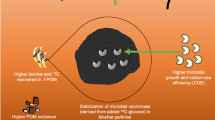Summary
The alder has a perennial nodule cluster. The nodule amount on the roots increases with tree age. The N2-fixing activity of nodules decreases with nodule age. Purple coloured soils with various soil pHs and CaCO3 contents are, in the main, the ones which influence nodulation and N2-fixing. Higher N2-fixing capacity existed in the neutral and low calcium soils. High calcium soils and acid soils can restrain nodulation and the N2-fixing rate significantly. On the slope, where calcarous light loams are found, the annual nitrogen fixation capacity of alder and cypress mixed plantations, less than 10 years old, is 16 or 17 kg/ha yr, but in the valley, a pure alder plantation can reach 40 kg/ha yr.
Similar content being viewed by others
References
Akkermans A D L and van Dijk C 1976 The formation and nitrogen fixing activity of the root nodule ofAlnus glutinosa under field condition.In Symbiotic Nitrogen Fixation in Plants. Eds. P S Nutman. pp 511–520. Cambridge University Press.
Akkermans A D L and van Dijk C 1981 Non-leguminous root-nodule symbioses with actinomycetes and rhizobium.In Nitrogen Fixation. Vol. 1, Ecology, Eds. W J Broughton. pp 74–92. Oxford University Press.
Bond G 1974 Root-nodule symbioses with actinomycete-like organisms.In The Biology of Nitrogen Fixation. Eds. A Quispel. pp 342–378. North-Holland.
Bond G 1983 Taxonomy and distribution of non-legume nitrogen-fixing system.In Biological Nitrogen Fixation in Forest Ecosystems: Foundations and Applications. Eds. J C Gordonet al. pp 55–87. Martinus Nijhoff/Dr. W. Junk.
Dixon R O D and Wheeler C T 1983 Biochemical, physiological and environmental aspects of symbiotic nitrogen fixation.In Biological Nitrogen Fixation in Forest Ecosystems: Foundation and Application. Eds. J C Gordonet al. pp 108–171. Martinus Nijhoff/Dr W. Junk.
Hardy R W F, Burns R C and Holsten R D 1973 Applications of the acetylene-ethylene assay for measurement of nitrogen fixation. Soil Biol. Biochem. 5, 47–81.
Liu Guofan and Deng Tingxiu 1983 The nodulation and nitrogen fixation in the saplings of several species of trees growing on the purple soils and their effects. Acta Ecologica Sinica 3, 4, 349–355.
Liu Guofan and Deng Tingxiu 1984 The relation of soil condition to nodulation and nitrogen fixation ofAlnus cremastogyne. Acta Pedological Sinica. 22,3, 251–257.
Masterson C T and Murphy P M 1980 The acetylene reduction technique.In Recent Advances in Biological Nitrogen Fixation. Eds. N J Subba Rao. pp 8–33. Oxford and TBH Publishing Company in India.
Sprent J I 1979 The biology of nitrogen-fixing organism. pp 78–102. McGRAW-HILL Book Company (UK) Limited.
Author information
Authors and Affiliations
Rights and permissions
About this article
Cite this article
Guofan, L., Tingxiu, D. A study of nodulation and nitrogen fixation of alder on the purplish soils in China. Plant Soil 99, 285–290 (1987). https://doi.org/10.1007/BF02370875
Received:
Revised:
Issue Date:
DOI: https://doi.org/10.1007/BF02370875




